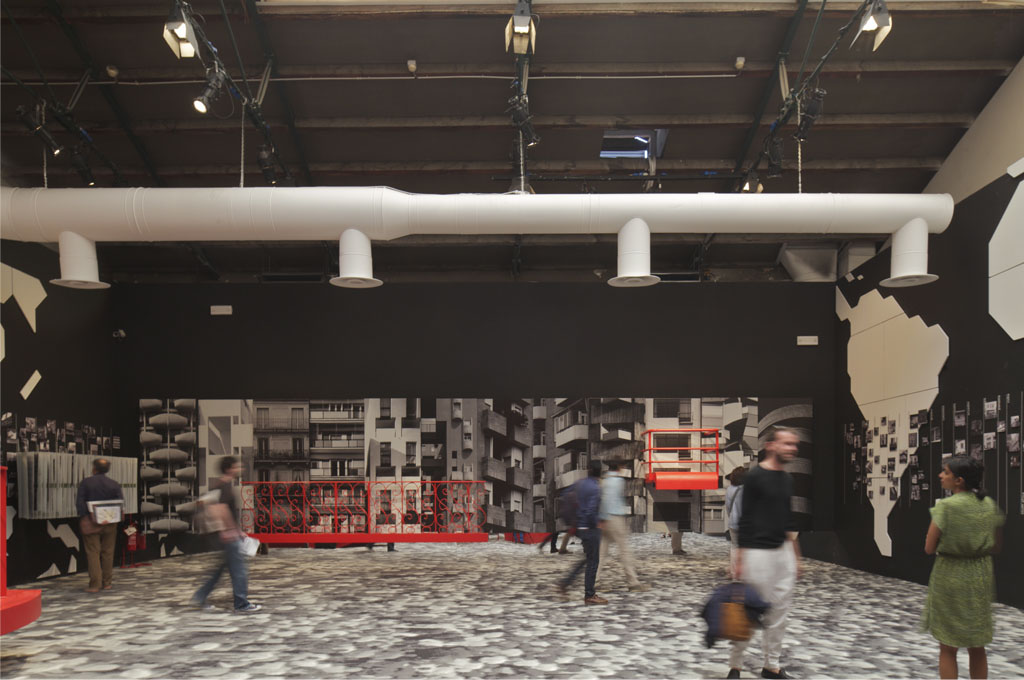31-08-17 // A MATTER OF ZOOMING – INTERVIEW WITH STEPHAN PETERMANN/ OMA

The “Balcony” room of the “Elements of Architecture” at the 2014 Venice Biennale of Architecture.
Photo by Philippe Ruault
Bernd Upmeyer interviewed Stephan Petermann from the Office for Metropolitan Architecture (OMA) on the topic of “Small Urbanism”. The main focus of the interview was on OMA’s “Elements of Architecture” project at the 2014 Venice Biennale of Architecture. The importance and effects of the “Elements of Architecture” for cities and the larger environment in general was discussed. Petermann was one of the associates in charge of Koolhaas’s Fundamentals’ Architecture Biennale in Venice in 2014. The interview took place in August 2017.
The Urban Impact of the Elements of Architecture
Bernd Upmeyer: We recently became fascinated with the small and almost unrecognizable elements within our cities, because we believe that often, the things in our cities that matter the most and have the largest effect on our urban environment, are precisely those small elements. That is why – with this new issue of MONU – we aim to start a discussion on small urban elements, and particularly small physical urban elements, and their importance for and effects on cities – whether spatially, socially, politically, econom-ically, ecologically, or philo-sophically – something we call “Small Urbanism”.
In 2014 you were part of the team of OMA that curated the Venice Biennale of Architecture under the theme “Fundamentals”. One of OMA’s contributions existed of the “Elements of Architecture” in the Central Pavilion. To what extent are the elements of architecture, such as the floor, the wall, the ceiling, etc. that you presented there also elements of urbanism?
Stephan Petermann: One of the interesting things of looking at elements is that you can find traces of urbanism in practically all elements – just like traces of movies, literature, economy, etc – even in the most banal or obvious. The balcony is obviously crucial as the physical platform between the public and private realm, between autocracy and democracy and the space of negotiation in between. In the roof chapter, we looked at the oldest complete treatise of architecture from China (Yingzao Fashi,1103AD), an actual building law which governed all public construction through the empire for centuries. The system was originally designed to reduce corruption and any forms of cost inflation. The construction system was the same for all, the scale and size of execution was a proportional system connected to a hierarchical social organization. In other words: the more influential your societal position, the larger the elements of the system one could build. A very simple, yet hugely creative rule, which has had massive impact on urbanism. Almost every element has a story like that to tell – which was great to discover.
BU: With the exhibitions of the Venice Biennale you wanted to illuminate the past, present, and future of the architectural discipline. However, in a lecture in 2015 you said that this project was not created with the explicit intent to come up with a new type of theory but to engage with a type of deeper understanding of the fundamentals of architecture. Did this project lead to a deeper understanding of the fundamentals of urbanism?
SP: One of the things I share with Rem is an inbuilt skepticism towards theory. I think Rem is very uncomfortable being called a theorist. Which is not that you don’t indulge in theories, or fantasize about them. I think for almost every spread in the elements book you could construct a theory, conduct brilliant PhD projects – we sometimes really had to contain ourselves not to get distracted too much in the project. It’s more like speculation, and functions as a way to find inspiring ways to look at objects. I think in this project we all shared a conviction that everything you look at can become interesting given the right illumination. One of the first rules of the project, which we gave to our groups of GSD (Harvard Graduate School of Design) students, was to try to forget everything you know, to pretend you come from Mars and have to describe what you see. Urbanism is not something that you can separate from this – every element has an urbanistic consequence – it is only a matter of zooming. Which might be a nice exercise to pursue after we finished the final version of the Elements book…
…the complete interview was published in MONU #27 on the topic of Small Urbanism on October 16, 2017.
Title: A Matter of Zooming
Project: Interview with Stephan Petermann/ OMA
Date: August 2017
Type: Commissioned interview
Topic: Small Urbanism
Organizer: MONU
Status: Published
Publications: MONU #27, P. 25-32
Interviewer: Bernd Upmeyer